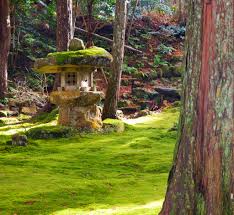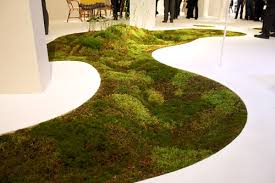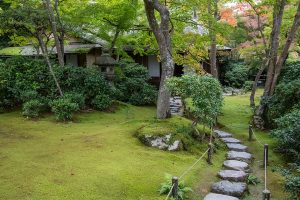STUDENT EXAMPLE: Moss Lawns
Alessandra Capasso
A Preface to Moss Lawns
The beauty and benefits of moss lawns are thought-inducing for surrounding communities. Those who witness it will likely consider the value of sustainability and ecological biodiversity in our environment. Moss lawns are simply lawns that use moss, a fitting alternative to grass used commonly in communities such as the United States. Grass requires an exhausting frequency of upkeep with the common results of an imperfect lawn. Moss, however, can maintain itself and use less of our resources providing a game-change to landscape architecture that will provide health to our environment. One country that could teach others about how moss can positively embellish lives is Japan.
Moss lawns encompass the theme of the significance of sustainability and the health of the environment as well as the theme of the beauty of our nature (which embraces artistic expression). Moss lawns fit the theme of sustainability and health for the environment since they require far less care than grass lawns in exchange for more benefits than grass lawns. For example, grass requires many more accommodations as it fits a specific type of environment, needs to be cut frequently, needs fertilizer (which is a pollutant), and needs a lot of patience. Moss could use some accommodations such as acidic and compound soil which can be solved with sulfur, but it needs much fewer resources than grass does as some additional rain will suffice for moss care. Moss is also supportive of biodiversity since it attracts many animals that could be considered visually pleasing including insects, reptiles, and birds to create a healthy food web and an appreciable biodiverse environment. The theme of the beauty of nature created by moss lawns is supported by the view of the moss lawn practice as an artistic expression because of their serene appearance and how they have the capabilities of attracting more beautiful life creating a feeling of unity and tranquility. Additionally, moss lawns can be personalized by any artist who wants to start one up in a unique way of expression.

This image showcases a moss garden as a product of typical Japanese Gardening. Japan is known for its work in Zen gardening for the public to enjoy. The origins of this image are not clear since all cities Kyoto, Fukui, and Tango are listed in the creator’s upload description, but the region Kansai could be denoting of where the image was taken. It was uploaded on January 1, 2014.

A moss carpet is displayed in Triennale, an art and design museum in Milan. The texture and life in the real moss carpet reveal the diversity and beauty of nature. According to Makoto Azuma, “my work for this exhibition shows the encounter and coexistence of two lifeforms with different origins. Living things connect strongly and straightforwardly, and conceal unlimited possibilities.” The Japanese artist Makoto Azuma additionally has an extensive history of botanical sculpting to show nature as an art form and will continue his work in the future. This image was uploaded on April 25, 2009.

Although visitors may come to visit the Okochi Sanso Garden in respect of the actor Denjirō Ōkōchi who previously lived in the villa, visitors also enjoy the garden for the Zen feeling created by nature by Japanese cultural standards. This includes the simplicity of the soft and self-sustaining moss which compliments the architecture it surrounds. Amongst the garden and villa are a museum for the former owner and a temple to meditate at. It is a salient characteristic that the appreciation of nature and mediation go hand in hand in Japan. This image was uploaded on November 3, 2016.
Looking at further research at the images displaying moss, they all can be traced back to the same origin. All images display the long-lived gardening culture of Japan. Part of Japanese culture is the intimacy and respect of nature leading to higher incorporation and protection of nature. Japanese Zen gardening consistently uses moss and it is not solely because of its abundance in Japanese nature, but for its ideals of transience and imperfection, also known as wabi and sabi. The simplicity of moss is also tied to Buddhist nature-appreciating values finding a moss landscape perfect to mediate with. Moss is so embedded into the culture of Japan that it is even mentioned in its national anthem.
The images above are inspiring to both appreciate nature as an environmental gift and celebrate it as an art form. After all, moss is incredibly talented at sustaining both itself and life around it. The exponential potential of variety in the ecological environment it creates leads to the artful gift of unity in nature as well. Just after a sulfuric and dense base of soil, moss is self-sustaining and attracts a wide variety of insects, then a variety of reptiles and amphibians, then a variety of birds, then a variety of mammals, and more. One could potentially attract colorful beetles, fireflies, birds, and create breathtaking scenery. People outside of this community who depend on grass could learn from Japan’s use of moss since grass is not nearly as supportive of other lifeforms, is far more demanding of water, uses harmful pesticides and fertilizers, and needs constant upkeep all to result in the eventual dying grass patches and balding.
All practices used in the images above use a clearer answer to an insufficient practice of grass. A reliable base like moss can be used to improve and embellish human and environmental life.
The culture and use of moss in Japan are integral to understanding its community values. The close bonded relationship between nature and people is unique to Japan and moss is among the adored parts of nature for Japan. Moss is considered significant for its appreciable transient, imperfect, and subtle beauty and it is celebrated by displaying moss in many gardens all around. Japan’s relationship with moss is also indicative of support for a healthy environment and appreciation of the beauty of nature which could be helpful for other surrounding communities. People apart from Japan, especially those who use too much grass, could take a look at its practices related to moss and learn to consider practices that allow sustainability within an environment, promotion of ecological diversity, and a celebration of nature’s exquisite qualities that all lead to the strengthening of a happy human environment.
- “Azuma Makoto: Flower Art Installations, News and Projects.” Designboom, 31 Dec. 2019, www.designboom.com/tag/azuma-makoto/.
- Burk, Cathy. “The Benefits & Ecology of a Moss Lawn.” Habitat Network, 7 May 2018, content.yardmap.org/learn/benefits-ecology-moss-lawn/.
- Choi, Leeji. “Azuma Makoto: ‘Time of Moss’ for Tokyo Fiber Senseware at Milan Design Week 09.” Designboom, 21 July 2014, www.designboom.com/design/makoto-azuma-time-of-moss-for-tokyo-fiber-senseware-at-milan-design-week-09/.
- Grant, Bonnie L. “Moss As Lawn Substitute: How To Grow A Moss Lawn.” GardeningKnowHow, 18 Apr. 2020, www.gardeningknowhow.com/lawn-care/lawn-substitutes/moss-lawn/how-to-grow-a-moss-lawn.htm.
- Hammett, James. “Japan’s Intimate Relationship with Nature.” Masami, 14 Jan. 2020, www.lovemasami.com/blogs/our-blog/japan-s-intimate-relationship-with-nature.
- P, Miki. “Okochi-Sanso Villa – The Most Breathtaking Villa in Arashiyama Kyoto.” Tokyo Creative Travel, www.tokyocreative.com/articles/20560-okochi-sanso-villa-the-most-breathtaking-villa-in-arashiyama-kyoto.
- Triennale Milano, triennale.org/en/visit/plan-your-visit.
- Wong, James. “Blade Runners: the Joy of Moss Lawns.” The Guardian, Guardian News and Media, 3 June 2018, www.theguardian.com/lifeandstyle/2018/jun/03/blade-runners-the-joy-of-moss-lawns.
- Yoshitaka, Oishi. “Japan’s Emerald Carpets: The Cultural Importance and Environmental Promise of Moss.” Nippon.com, 30 May 2020, www.nippon.com/en/japan-topics/b02350/japan%E2%80%99s-emerald-carpets-the-cultural-importance-and-environmental-promise-of-moss.html.

